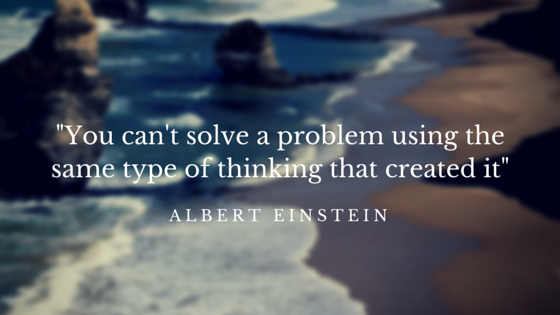5 ways leaders can be more innovative

Thinking outside the box to improve productivity, innovation and competitive advantage isn’t as challenging as many leaders think. We’ve been working with leaders who struggle with being innovative and together we’ve created 5 simple ways to think outside the box on a daily basis. They are now anticipating customers’ needs and are agile and strategic in their leadership of change. Their people are no longer frustrated, de-motivated and stuck. So without further ado, here’s our 5 simple ways that leaders can be more innovative and think outside the box: 1. Take 20 minutes out every day to think 80% of leaders don’t take enough time to think. Our brain is a phenomenal resource and yet most of us do not create high quality thinking time in a day to expand our brain, improve its plasticity and allow new thoughts to come in.  How much quality thinking time do you allow in a typical day? Are you using your brain to its fullest potential? Neuroscientists are constantly proving the ability of the brain to change itself. Neuroplasticity of the brain means we are able to learn new information whenever we need it. The information stored in our brains is the very basis of our human ability to be creative and to come up with new solutions to problems. We can choose to be more innovative, by taking time to think for 20 minutes every day. If we don’t make use of the new neurones and synapses (the tiny gaps across which a neuron can send an impulse to another neuron) we are creating when we come up with new thoughts, we will lose them. So the old adage “use it or lose it” stands true. 2. Create an enriching, safe environment around you and stimulate yourself with daily aerobic exercise Until recently it was thought that humans were born with all of the neurons they would ever have. However it’s now proven that new neurons are created in some parts of the brain dependent upon the context. Research has shown that if we want to expand our ability to be creative and innovative we need to actively encourage the development of new neurons. Aerobic exercise stimulates neuron production. We make fewer new neurones when we are depressed or anxious, so positively endorsing people, providing an emotionally safe environment of trust and openness, and encouraging playfulness and humour all help create new neural pathways.
How much quality thinking time do you allow in a typical day? Are you using your brain to its fullest potential? Neuroscientists are constantly proving the ability of the brain to change itself. Neuroplasticity of the brain means we are able to learn new information whenever we need it. The information stored in our brains is the very basis of our human ability to be creative and to come up with new solutions to problems. We can choose to be more innovative, by taking time to think for 20 minutes every day. If we don’t make use of the new neurones and synapses (the tiny gaps across which a neuron can send an impulse to another neuron) we are creating when we come up with new thoughts, we will lose them. So the old adage “use it or lose it” stands true. 2. Create an enriching, safe environment around you and stimulate yourself with daily aerobic exercise Until recently it was thought that humans were born with all of the neurons they would ever have. However it’s now proven that new neurons are created in some parts of the brain dependent upon the context. Research has shown that if we want to expand our ability to be creative and innovative we need to actively encourage the development of new neurons. Aerobic exercise stimulates neuron production. We make fewer new neurones when we are depressed or anxious, so positively endorsing people, providing an emotionally safe environment of trust and openness, and encouraging playfulness and humour all help create new neural pathways.  Safe environments stimulate the production of neurotransmitters like oxytocin and dopamine which promote feelings of wellbeing. Being in a stimulating environment that enriches us boosts our neuron production. So take yourself to places that inspire you, be with people who stimulate your thinking. Take a walk in nature, get out of the office, do things that stimulate you and you will build your idea proficiency! 3. Change your conscious/subconscious focus, combining slow and fast thinking Too many leaders are over-focused on their conscious thinking brain and rarely put their heart brain (feelings) and infinite brain (gut and subconscious intelligence) into gear. Connecting to our heart and our subconscious, in addition to our conscious intellect, can make a significant difference from an innovation point of view. Nobel Prize winner Daniel Kahneman introduced terms to describe two types of decision-making available in the brain. He noted the conscious processes and the subconscious processes. Our conscious processes are slow and subject to reasoning or cost-benefit analysis. They slow us down and can limit imagination. Coming up with ideas focusing purely on the conscious thinking brain is what holds many leaders back. Where we often get the biggest benefit from being innovative is when we shift to unconscious “fast thinking” mode. Here we are connecting much more with the heart and the infinite brain. The unconscious is fast, holistic and based on measuring previous patterns in order to draw conclusions about potential actions. Fast thinking is implicit, automatic and usually requires low effort as it operates independently of intellectual intelligence. We can all shift our focus from conscious to unconscious by changing our breathing. The more we allow ourselves to use our whole brain (conscious and unconscious) and ask ourselves the expansive blue sky questions, we will create step changes in our creativity and innovation.
Safe environments stimulate the production of neurotransmitters like oxytocin and dopamine which promote feelings of wellbeing. Being in a stimulating environment that enriches us boosts our neuron production. So take yourself to places that inspire you, be with people who stimulate your thinking. Take a walk in nature, get out of the office, do things that stimulate you and you will build your idea proficiency! 3. Change your conscious/subconscious focus, combining slow and fast thinking Too many leaders are over-focused on their conscious thinking brain and rarely put their heart brain (feelings) and infinite brain (gut and subconscious intelligence) into gear. Connecting to our heart and our subconscious, in addition to our conscious intellect, can make a significant difference from an innovation point of view. Nobel Prize winner Daniel Kahneman introduced terms to describe two types of decision-making available in the brain. He noted the conscious processes and the subconscious processes. Our conscious processes are slow and subject to reasoning or cost-benefit analysis. They slow us down and can limit imagination. Coming up with ideas focusing purely on the conscious thinking brain is what holds many leaders back. Where we often get the biggest benefit from being innovative is when we shift to unconscious “fast thinking” mode. Here we are connecting much more with the heart and the infinite brain. The unconscious is fast, holistic and based on measuring previous patterns in order to draw conclusions about potential actions. Fast thinking is implicit, automatic and usually requires low effort as it operates independently of intellectual intelligence. We can all shift our focus from conscious to unconscious by changing our breathing. The more we allow ourselves to use our whole brain (conscious and unconscious) and ask ourselves the expansive blue sky questions, we will create step changes in our creativity and innovation.
“As long as you’re going to think anyway, think big” – Donald Trump
4. Stimulate your prefrontal cortex by having adequate sleep, a great diet and managing stress levels Our brains have developed from the expansion of three key components: the hindbrain (brainstem), the midbrain and the forebrain. The largest expansion can be found in the forebrain and specifically in the prefrontal cortex. The prefrontal cortex is the seat of judgement, emotional regulation and executive functioning. This allows and encourages higher-level thinking and gives us the functionality of coming up with new ideas and innovations.  Something to be aware of however, is the pre-frontal cortex uses a large share of the body’s glucose and oxygen and is very sensitive to external factors such as diet, sleep and stress. We can encourage better quality thinking by stimulating our prefrontal cortex and improving the quality of our sleep. Most people need around eight hours sleep a night. How about you? Diet is also fundamental. Do you eat healthily? How well are you digesting your food? Finally, are you experiencing healthy levels of stress? If you are over-stressed, your body will be releasing cortisol and adrenaline which can shut down the brain’s higher level thinking abilities. 5. Use the four stages of innovative thinking model to think outside the box on a regular basis
Something to be aware of however, is the pre-frontal cortex uses a large share of the body’s glucose and oxygen and is very sensitive to external factors such as diet, sleep and stress. We can encourage better quality thinking by stimulating our prefrontal cortex and improving the quality of our sleep. Most people need around eight hours sleep a night. How about you? Diet is also fundamental. Do you eat healthily? How well are you digesting your food? Finally, are you experiencing healthy levels of stress? If you are over-stressed, your body will be releasing cortisol and adrenaline which can shut down the brain’s higher level thinking abilities. 5. Use the four stages of innovative thinking model to think outside the box on a regular basis  STAGE 1: EXPANDING POTENTIAL “”Do not follow where the path may lead… Go instead where there is no path and leave a trail.” (Robert Frost) This is about challenging conventional thinking, allowing yourself to take risks, seeing potential beyond the current boundaries and shaping a future vision that transcends existing paradigms. Your mind-set is critical here. How open are you to possibility? Do you move beyond “what is” and imagine a compelling vision of “what could be?” STAGE 2: CREATING POSSIBILITIES “Ideas are like rabbits. You get a couple, learn how to handle them, and pretty soon you have a dozen.” (John Steinbeck) Assuming you’ve created a safe, encouraging environment that stimulates you and inspires creative thinking. You can use tools and techniques that foster divergent thinking and idea generation, such as the ‘Brainsparker’ app, created by our associate Gabriella Goddard. STAGE 3: INSPIRING ENGAGEMENT “You can have brilliant ideas, but if you can’t get them across, your ideas won’t get you anywhere.” (Lee Lacocca) Some people won’t “get” the potential of your idea or concept immediately. Focus on honing your ability to engage others, communicate your ideas in a clear and impactful way, use narrative story-telling and encourage collaboration with others to help pave the way. STAGE 4: CATALYSING IMPLEMENTATION “The most effective way to do it…is to do it!” – (Amelia Earhart) Being innovative is not a start/stop process, it’s a mind-set and way of being. Be willing to step into the unknown and constantly improve, grow and innovate the way things are. Being innovative is about disrupting your routine and opening up your brain to new ideas. As Albert Einsten said “You can’t solve a problem using the same type of thinking that created it”. So let’s think differently, let’s innovate our way to a greater business impact. Good luck and enjoy yourself!
STAGE 1: EXPANDING POTENTIAL “”Do not follow where the path may lead… Go instead where there is no path and leave a trail.” (Robert Frost) This is about challenging conventional thinking, allowing yourself to take risks, seeing potential beyond the current boundaries and shaping a future vision that transcends existing paradigms. Your mind-set is critical here. How open are you to possibility? Do you move beyond “what is” and imagine a compelling vision of “what could be?” STAGE 2: CREATING POSSIBILITIES “Ideas are like rabbits. You get a couple, learn how to handle them, and pretty soon you have a dozen.” (John Steinbeck) Assuming you’ve created a safe, encouraging environment that stimulates you and inspires creative thinking. You can use tools and techniques that foster divergent thinking and idea generation, such as the ‘Brainsparker’ app, created by our associate Gabriella Goddard. STAGE 3: INSPIRING ENGAGEMENT “You can have brilliant ideas, but if you can’t get them across, your ideas won’t get you anywhere.” (Lee Lacocca) Some people won’t “get” the potential of your idea or concept immediately. Focus on honing your ability to engage others, communicate your ideas in a clear and impactful way, use narrative story-telling and encourage collaboration with others to help pave the way. STAGE 4: CATALYSING IMPLEMENTATION “The most effective way to do it…is to do it!” – (Amelia Earhart) Being innovative is not a start/stop process, it’s a mind-set and way of being. Be willing to step into the unknown and constantly improve, grow and innovate the way things are. Being innovative is about disrupting your routine and opening up your brain to new ideas. As Albert Einsten said “You can’t solve a problem using the same type of thinking that created it”. So let’s think differently, let’s innovate our way to a greater business impact. Good luck and enjoy yourself!



